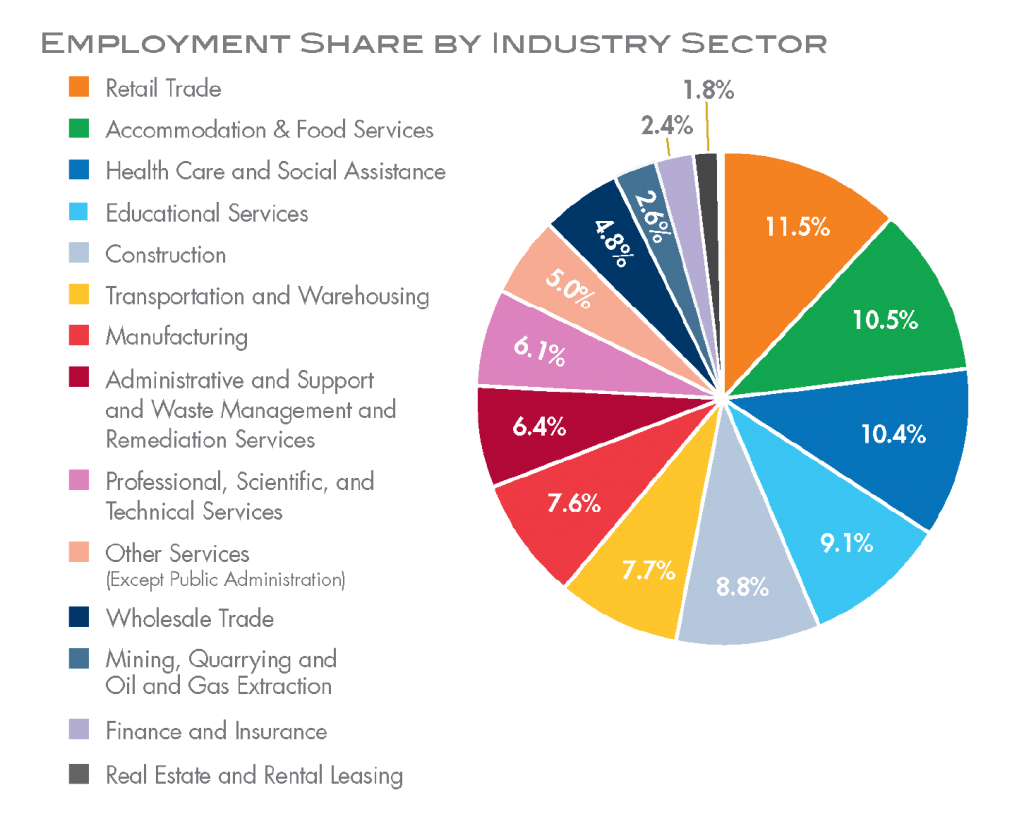Cost of Living Index
The Cost of Living Index estimates the relative price levels for consumer goods and services. When applied to wages and salaries, the result is a measure of relative purchasing power. The cost of living is 4.0% lower in NHA Service Area than the U.S. average.
[supsystic-tables id=3]Education Levels
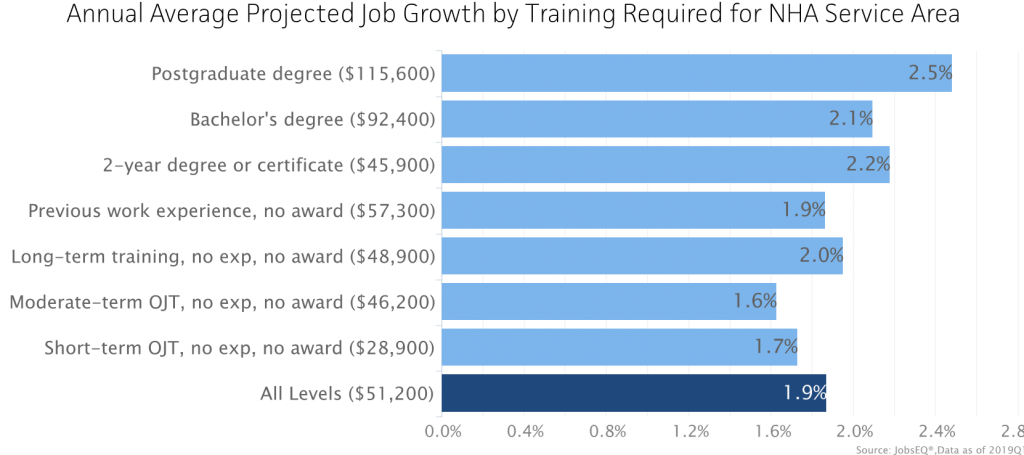
Expected growth rates for occupations vary by the education and training required. While all employment in the NHA Service Area is projected to grow 1.9% over the next ten years, occupations typically requiring a postgraduate degree are expected to grow 2.5% per year, those requiring a bachelor’s degree are forecast to grow 2.1% per year, and occupations typically needing a 2-year degree or certificate are expected to grow 2.2% per year.
Employment Trends
As of 2019Q1, total employment for the NHA Service Area was 667,104 (based on a four-quarter moving average). Over the year ending 2019Q1, employment increased 1.8% in the region.
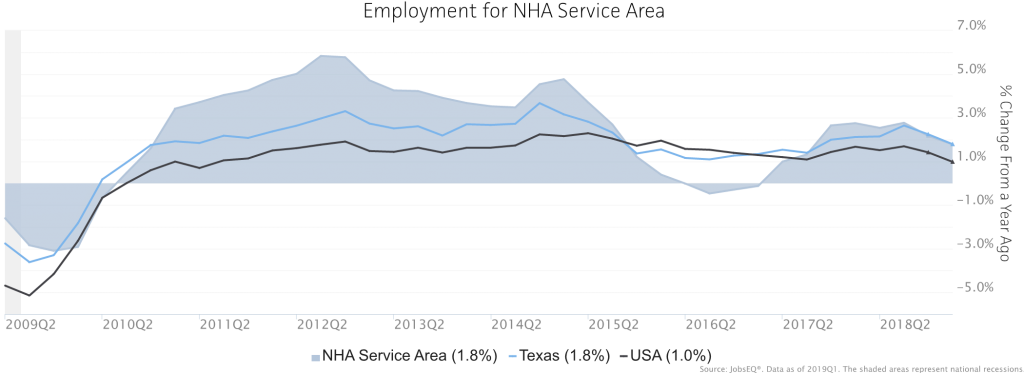
Wage Trends
The average worker in the NHA Service Area earned annual wages of $63,251 as of 2019Q1. Average annual wages per worker increased 1.1% in the region over the preceding four quarters. For comparison purposes, annual average wages were $55,825 in the nation as of 2019Q1.
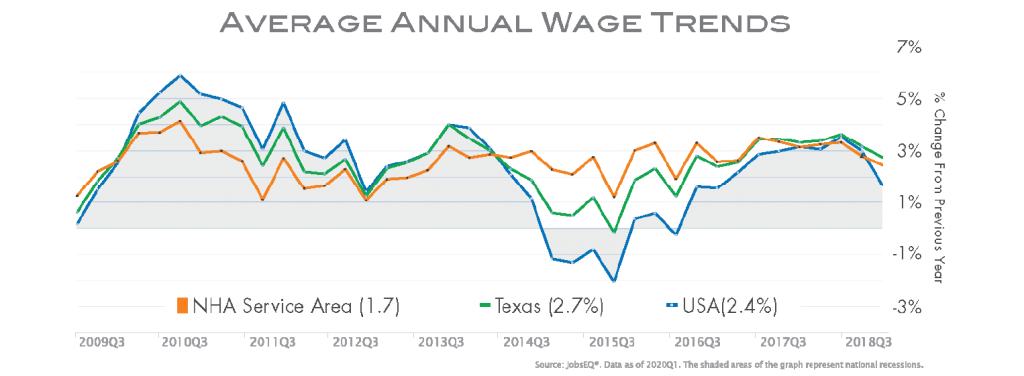
The largest sector in the NHA Service Area is Retail Trade, employing 79,841 workers.
The next-largest sectors in the region are Accommodation and Food Services (70,583 workers) and Health Care and Social Assistance (70,046).
High location quotients (LQs) indicate sectors in which a region has high concentrations of employment compared to the national average.
The sectors with the largest LQs in the region are Mining, Quarrying, and Oil and Gas Extraction (LQ = 5.57), Construction (1.55), and Transportation and Warehousing (1.53).
Sectors in the NHA Service Area with highest average wages per worker are Management of Companies and Enterprises ($171,968), Mining, Quarrying, and Oil and Gas Extraction ($167,241), and Utilities ($109,864). Regional sectors with the best job growth (or most moderate job losses) over the last 5 years are Health Care and Social Assistance (+12,311 jobs), Accommodation and Food Services (+11,760), and Construction (+9,253).
Over the next year, employment in the NHA Service Area is projected to expand by 12,477 jobs. The fastest growing sector in the region is expected to be Mining, Quarrying, and Oil and Gas Extraction with a +3.1% year-over-year rate of growth. The strongest forecast by number of jobs over this period is expected for Health Care and Social Assistance (+1,997 jobs), Construction (+1,356), and Accommodation and Food Services (+1,290).
Industry Clusters
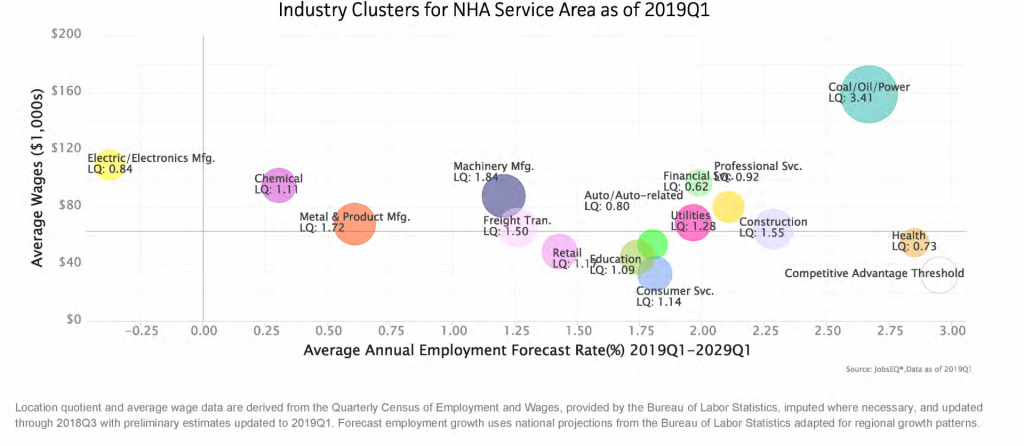
A cluster is a geographic concentration of interrelated industries or occupations. The industry cluster in the NHA Service Area with the highest relative concentration is Coal/Oil/Power with a location quotient of 3.41. This cluster employs 20,444 workers in the region with an average wage of $158,887. Employment in the Coal/Oil/Power cluster is projected to expand in the region about 2.7% per year over the next ten years
Occupation Snapshot
The largest major occupation group in the NHA Service Area is Office and Administrative Support Occupations, employing 97,718 workers. The next-largest occupation groups in the region are Sales and Related Occupations (74,054 workers) and Food Preparation and Serving Related Occupations (68,192). High location quotients (LQs) indicate occupation groups in which a region has high concentrations of employment compared to the national average. The major groups with the largest LQs in the region are Construction and Extraction Occupations (LQ = 1.56), Architecture and Engineering Occupations (1.20), and Food Preparation and Serving Related Occupations (1.19).
Occupation groups in the NHA Service Area with the highest average wages per worker are Management Occupations ($131,400), Legal Occupations ($123,900), and Architecture and Engineering Occupations ($105,600). The unemployment rate in the region varied among the major groups from 1.5% among Healthcare Practitioners and Technical Occupations to 7.3% among Farming, Fishing, and Forestry Occupations.
Over the next year, the fastest growing occupation group in the NHA Service Area is expected to be Healthcare Support Occupations with a +3.2% year-over-year rate of growth. The strongest forecast by number of jobs over this period is expected for Food Preparation and Serving Related Occupations (+1,313 jobs) and Office and Administrative Support Occupations (+1,288). Over the same period, the highest separation demand (occupation demand due to retirements and workers moving from one occupation to another) is expected in Food Preparation and Serving Related Occupations (12,481 jobs) and Office and Administrative Support Occupations (11,401).

